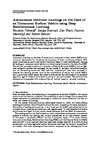Autonomous Vehicular Landings on the Deck of an Unmanned Surface Vehicle using Deep Reinforcement Learning
| dc.contributor.author | Polvara, R | |
| dc.contributor.author | sharma, sanjay | |
| dc.contributor.author | Wan, Jian | |
| dc.contributor.author | Manning, Andrew | |
| dc.contributor.author | Sutton, R | |
| dc.date.accessioned | 2019-04-08T12:50:31Z | |
| dc.date.available | 2019-04-08T12:50:31Z | |
| dc.date.issued | 2019-04-08 | |
| dc.identifier.issn | 0263-5747 | |
| dc.identifier.issn | 1469-8668 | |
| dc.identifier.uri | http://hdl.handle.net/10026.1/13683 | |
| dc.description.abstract |
<jats:title>Summary</jats:title><jats:p>Autonomous landing on the deck of a boat or an unmanned surface vehicle (USV) is the minimum requirement for increasing the autonomy of water monitoring missions. This paper introduces an end-to-end control technique based on deep reinforcement learning for landing an unmanned aerial vehicle on a visual marker located on the deck of a USV. The solution proposed consists of a hierarchy of Deep Q-Networks (DQNs) used as high-level navigation policies that address the two phases of the flight: the marker detection and the descending manoeuvre. Few technical improvements have been proposed to stabilize the learning process, such as the combination of vanilla and double DQNs, and a partitioned buffer replay. Simulated studies proved the robustness of the proposed algorithm against different perturbations acting on the marine vessel. The performances obtained are comparable with a state-of-the-art method based on template matching.</jats:p> | |
| dc.format.extent | 1-16 | |
| dc.language | en | |
| dc.language.iso | en | |
| dc.publisher | Cambridge University Press (CUP) | |
| dc.subject | Deep reinforcement learning | |
| dc.subject | Unmanned aerial vehicle | |
| dc.subject | Autonomous agents | |
| dc.title | Autonomous Vehicular Landings on the Deck of an Unmanned Surface Vehicle using Deep Reinforcement Learning | |
| dc.type | journal-article | |
| dc.type | Journal Article | |
| plymouth.author-url | https://www.webofscience.com/api/gateway?GWVersion=2&SrcApp=PARTNER_APP&SrcAuth=LinksAMR&KeyUT=WOS:000510674200003&DestLinkType=FullRecord&DestApp=ALL_WOS&UsrCustomerID=11bb513d99f797142bcfeffcc58ea008 | |
| plymouth.issue | 11 | |
| plymouth.volume | 37 | |
| plymouth.publication-status | Published | |
| plymouth.journal | Robotica | |
| dc.identifier.doi | 10.1017/s0263574719000316 | |
| plymouth.organisational-group | /Plymouth | |
| plymouth.organisational-group | /Plymouth/Faculty of Science and Engineering | |
| plymouth.organisational-group | /Plymouth/Faculty of Science and Engineering/School of Biological and Marine Sciences | |
| plymouth.organisational-group | /Plymouth/Faculty of Science and Engineering/School of Engineering, Computing and Mathematics | |
| plymouth.organisational-group | /Plymouth/REF 2021 Researchers by UoA | |
| plymouth.organisational-group | /Plymouth/REF 2021 Researchers by UoA/UoA07 Earth Systems and Environmental Sciences | |
| plymouth.organisational-group | /Plymouth/REF 2021 Researchers by UoA/UoA12 Engineering | |
| plymouth.organisational-group | /Plymouth/Research Groups | |
| plymouth.organisational-group | /Plymouth/Research Groups/Marine Institute | |
| plymouth.organisational-group | /Plymouth/Users by role | |
| plymouth.organisational-group | /Plymouth/Users by role/Academics | |
| plymouth.organisational-group | /Plymouth/Users by role/Researchers in ResearchFish submission | |
| dcterms.dateAccepted | 2019-02-27 | |
| dc.rights.embargodate | 2019-10-8 | |
| dc.identifier.eissn | 1469-8668 | |
| dc.rights.embargoperiod | Not known | |
| rioxxterms.versionofrecord | 10.1017/s0263574719000316 | |
| rioxxterms.licenseref.uri | http://www.rioxx.net/licenses/all-rights-reserved | |
| rioxxterms.licenseref.startdate | 2019-04-08 | |
| rioxxterms.type | Journal Article/Review |


